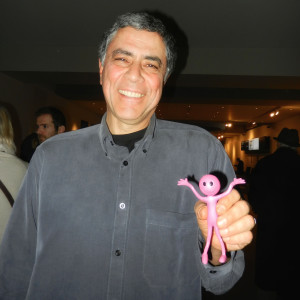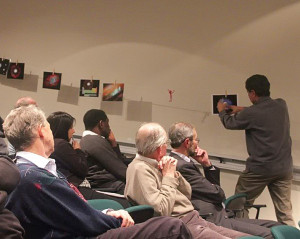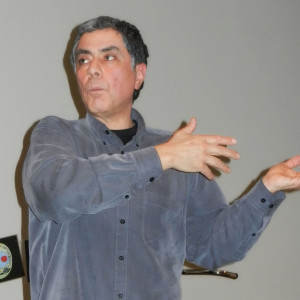January 21, 2013
Aliens! … Where are you?
Dr Francisco Diego
Report by: Chris Sutcliffe
Dr Francisco Diego is Senior Research Fellow in the Department of Physics and Astronomy at University College London. As a keen populariser of astronomy, he was one of the driving forces behind the formation of the Flamsteed Astronomy Society and presented the first lecture back in 1999.
Francisco’s lecture showed how unlikely it was for complex life to form in the Universe. To get to that point, he took us on a journey of the history of the Universe and how our understanding of the Universe has changed over time.
Hundreds of years ago, people thought that the Earth was at the centre of the Universe. The motions of the planets, however, did not conform to this theory and various solutions were put forward to explain this. For example, Tycho Brahe, the great observational astronomer (1546-1601) postulated that the Moon and the Sun revolve around the Earth, with the planets revolving around the Sun. Copernicus was the first to suggest that the Earth and all of the planets revolved around the Sun, but he and all of his followers were persecuted by the Church for these beliefs.
One of the most important figures in this story is Giordano Bruno (1548-1600) a philosopher who lived in Italy. He was a defender of Copernican ideas and stated that there were ‘an infinite number of worlds of the same kind as our own’. These ideas caused him to be accused of heresy and he was burned at the stake in 1600.
When Galileo used a telescope for the first time to view the Moon and then Jupiter and its moons in 1610, it was clear that other worlds did exist. Kepler used Tycho Brahe’s observations in developing his laws of planetary motion. This confirmed that the Earth is not at the centre, but a planet in an elliptical orbit around the Sun.
Francisco then developed a graphically illustrated time-line of the universe, using a rope stretched along the side of the lecture theatre! It represented the Universe from the time of the Big Bang 13.77 billion years ago to the present day, with each millimetre representing 2 million years.
On the timeline, Francisco described the following events:
| TIME (from the big bang) | |
|---|---|
| 0 | Big bang |
| 300-400 thousand years | Hydrogen and helium atoms are formed |
| 400 million years | First generation of stars formed from gravitational collapse of gas clouds |
| 500-600 million years | Stars run out of fuel and explode in supernovas |
| Clouds of protons and neutrons form atoms | |
| The force of gravity starts to form galaxies | |
| 2,000-3,000 million years | Most of the chemical elements in the periodic table have been formed by supernovae |
| 4,000 million years | Left-over material from star formation starts to form planets. These were the worlds that Giordano Bruno was talking about. Once you have the planets, you have the possibility of alien life! |
| Billions of solar systems could have been formed over billions of years | |
| Eventually stars end their life, so any aliens would have to find a way of getting away from their star |
| TIME (going back in time) | |
|---|---|
| 4,567 million years ago | Our solar system is formed. Evidence comes from the age of the earliest meteorites |
| 2,000 million years ago | Evolution from prokaryotic cells to eukaryotic cells |
| 500-600 million years ago | Complex life in the oceans |
| 300-400 million years | Ammonites are formed |
Francisco explained that many different conditions must exist in order for life to evolve:
The right star at the right distance.
Stars must be not too massive. Medium-sized stars live for thousands of millions of years, allowing time for life to develop. Also, the planet must be at the right distance, so that the conditions are not too hot or too cold.
The right moon at the right distance, which provides the tides
In the early Solar System, collisions between planets were frequent, and the Earth was sharing an orbit with a Mars-sized planet known as “Theia”. When the collision with the Earth took place, the Earth became larger and material flew off to form the Moon, about 4.5 billion years ago. Had Theia been a larger planet or had hit the Earth in a head-on collision, both planets could have been destroyed.
Accidental cataclysmic collisions.
Most of the water on Earth has come from comets.
A stable polar axis
The Moon’s orbit stabilises the axis of the Earth as a result of the gyroscopic effect in the force of gravity between the Earth and the Moon. The tilt in the axis of the Earth has been relatively constant unlike the other planets. This is important because a stable axis brings more or less constant global weather, which is important for the development of life.
Tides and volcanic activity
The Moon produces tides, which creates pockets of water, leading to some interesting chemistry to take place. In conjunction with volcanic eruptions, molecules are created which are the basic building blocks of life. See the Miller-Urey experiment for more details.
Molecules are also created at the bottom of oceans, with volcanic activity arising from plate tectonics. The motion of the continents is due to the interface between the lighter rock of the continents floating on the mantle, and the heavier rock at the bottom of the oceans. This interface is lubricated and cooled by liquid water. Without liquid water, the interface would stop and the Earth would become geologically dead, like Venus and Mars.
Photosynthesis
DNA and the first cells, such as bacteria, evolved when the Earth was only a few hundred million years old. Some of these bacteria (e.g. cyanobacteria) used photosynthesis to take molecules from the atmosphere, such as carbon dioxide and water, and split them to produce nutrients and release free oxygen back into the atmosphere. This helped to convert the planet from a ‘hell’, clouded in greenhouse gases, to a cooler Earth with a transparent atmosphere, preserving the liquid water, creating the paradise that we know today.
If we are able to detect a planet with free oxygen in the atmosphere, that would be evidence of photosynthesis and therefore direct proof of life.
Magnetic field
Inside the Earth, the molten outer core creates a magnetic field, which is crucial to our survival as it provides a shield protecting us from the lethal radiation of the Sun.
Extinctions
Various global catastrophes have caused mass extinctions in the past effectively ending the dominance of certain evolutionary groups and promoting others. The extinction event that put paid to the dinosaurs eventually caused mammals, in the form of apes, to be dominant. The human brain has evolved into the most complex structure in the Universe.
Complexity
Francisco then explained that intelligence requires complexity, and complexity requires diversity. That diversity is what Charles Darwin refers to in “The Origin of Species”, with its iconic tree of life.
Chances of intelligent life
Francisco believes that it is very likely that evidence of fossilised microscopic life will be found on Mars in the future. On Europa, there may be bacteria in the oceans beneath the frozen surface. However, it is easy to make bacteria, but the step to make prokaryotic cells and then to eukaryotic cells is enormous.
There are an immeasurable number of worlds similar to ours, as Giordano Bruno suspected. But, are we going to find all of the conditions that we believe are necessary for intelligent life?
There are over 200,000,000,000 stars in the Milky Way Galaxy, and around 200,000,000,000 galaxies in the observable Universe. However, if you place reasonable probabilities on the likelihood of all the conditions being met to form intelligent life and multiply them together (see Drake equation), it is possible to show that you would need 250 Universes to find another Earth!
This gives an idea of the problem of alien life… how accidental it is. It’s a miracle as the chemicals and the conditions required for life on Earth are very difficult to reproduce. If there were aliens, we should have millions of flying saucers. The absence of evidence for aliens is evidence for absence.
Francisco concluded that we are in isolation and are the only ones; there is no one else in the Universe and, in 4,000 million years when the Sun dies, we will be gone! We have to escape and explore.
By any standards, this was a fascinating lecture and prompted a huge amount of debate amongst members after the lecture. Our thanks to Dr Francisco Diego.
Pictures from the evening (by Grey Lipley, Malcolm Porter and Mike Meynell):
Posted under: Flamsteed, Flamsteed Lecture, Meeting Report














You must be logged in to post a comment.